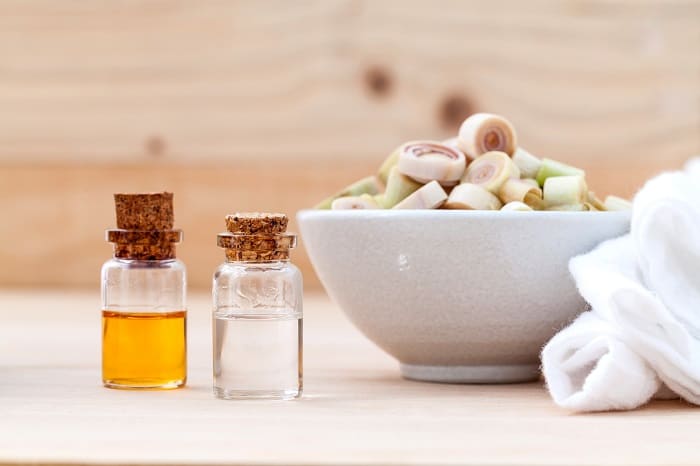Last Updated on October 7, 2024
Lemongrass oil has a lot of amazing benefits. If you have a herb garden at home, then harvesting some lemongrass and making them into an oil solution would greatly benefit you. You can use this topically to treat inflammation or fungal infections. You can even use this to incorporate in your homemade insect repellent.
Indeed, lemongrass can be used in a lot of ways. It’s no wonder why a lot of people want to know how to make lemongrass oil. That’s why I’ve come up with this guide to show to the readers how easy it is to make one. Follow the steps below to create the best lemongrass oil at home.
Table of Contents
Things You’ll Need to Make Lemongrass Oil
Here, we will discuss the two ways on how to make lemongrass oil and what materials are needed for each. If you’re planning to make one soon, make sure that you have all of these items prepared:
- Cold Infusion Method – This is a simpler way to make lemongrass oil. It only uses few materials. However, it takes more time to make.
- Hot Infusion Method – This requires more items and steps. However, it can be done within a day, so it’s convenient when it comes to time.
Primary Things Needed for Both Methods
- Lemongrass Stalks – This is the star of the show, lemongrass. Gather around 4 to 5 stalks for this. If they’re small, and you’d want a much more potent solution, you can pick up more stalks. Just make sure that they’re all healthy and are not too young for harvesting.
- Oil – This will serve as your base when making the lemongrass oil. Choose from coconut, grapeseed, or almond oil. A quart of your chosen oil will do.
- Bottles – These will serve as your containers when you’re done making the lemongrass oil.
- Cheesecloth – This is used to act as a strainer to filter the oil.

Separate Items Needed for Each Method
Cold Infusion
- Canning Jars – Any jar that’s big enough to accommodate a quart of oil will suffice. Make sure that they have airtight lids.
- Mortar and Pestle – These will be used to crush the lemongrass to extract the oil.
Hot Infusion
- Glass Jug – Any glass jug will do as well. This is simply needed as a container.
- Double Boiler – This is needed to heat your solution.
- Wine Press – This will also be used to crush the lemongrass to extract the oil.
Both methods have their own pros and cons and are effective when it comes to making lemongrass oil. However, if you only have common items at home, you can follow the cold infusion as it only needs a few items that you can easily find in the house.
Though this method takes time, it does not require a lot of steps anyway. You just need to wait. This is the reason why I prefer this method. But if you do have all of the items needed for the hot infusion, you can follow it as it will only take a few hours.
Step-By-Step Guide to Make the Lemongrass Oil
When you have everything prepared, you can now start making the lemongrass oil. Just pick a method that you prefer.
Cold Infusion Method
Step 1: Get your lemongrass stalks and cut them in smaller pieces.
Step 2: Place the lemongrass pieces in your mortar and pestle and crush them until the oil is released.
Step 3: Add the crushed pieces into your canning jars and pour in the oil of your choice. Cover the lid tightly and place the jar in an area that’s sunny all day.
Step 4: After two days, strain the lemongrass by using a cheesecloth as you pour it into another canning jar.
Step 5: Repeat steps 1 and 2, then add the new batch of the crushed lemongrass into the jar. Let it sit for another 2 days.
Step 6: After 2 days, if you’re satisfied, you can already place the lemongrass oil in your bottles. Store them in a dark and cool place.
Hot Infusion Method
Step 1: Boil water in your double boiler.
Step 2: Cut your lemongrass into pieces and add them in the double boiler with the oil of your choice.
Step 3: Let the lemongrass and oil simmer in the double boiler gently for 3 hours.
Step 4: Prepare your wine press with a plastic tube and place it on an elevated surface so that you can place your jug underneath it.
Step 5: Place the cheesecloth to the winepress’ rim and pour the lemongrass oil through it.
Step 6: Transfer the oil from the jug to the bottle. Store them in a dark and cool place.
Additional Tips
- You can use the lemongrass solution for a year. However, if you notice a rancid smell, throw the oil and just make a new batch.
- Do not expose the oil outside your storage area for too long. Too much ultraviolet rays can lessen the oil’s effectiveness. Always store the bottles in a dark and cool area to prolong their longevity.
- When boiling the lemongrass and oil in the double boiler, make sure to do this for 3 hours. Do not let them boil too much, just simmer gently.
- If you’re not tested yet, use a little bit of oil and apply on a small area of your skin. This will help you check if you’re allergic or sensitive to it.
- Lemongrass is an edible herb. However, when it’s in its oil form, it can only be used topically. Make sure that you let the people in your house know.
Conclusion
Have you had fun reading this simple how-to guide? As lemongrass oil has a lot of great benefits, sharing the steps on how to make it is important so that more and more people can benefit from this amazing oil. With this guide, you can now apply this topically for any fungal or inflammation problems that you have.
What do you think of this process? Do you have more suggestions as to how to make lemongrass oil? If so, leave your comments and ideas below.

Lacey is an environmental enthusiast and passionate advocate for living green and sustainable. She believes that everyone can make a difference, no matter how small. Lacey is dedicated to reducing her own carbon footprint and educating others on the importance of living greener. She is an advocate for green energy and sustainable practices. She is an active member of her local community, volunteering with local conservation efforts, and taking part in sustainability initiatives. Lacey is a firm believer that the only way to ensure a sustainable future is to work together and make small, but important changes.

